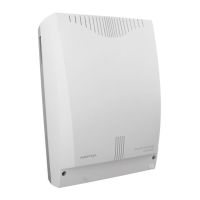Ascotel IntelliGate 2025/2045/2065
Part 5 Configuration Steps 857
12. Define the routes (see "Route", page 219)
–Name
– Allocate the trunk group
– Number of outgoing connections
– NPI for the call number
– Other settings as required
13. Edit the table of clock sources.
Key Telephones
14. Allocate the line keys of the key telephones to KT lines.
(see "Key Telephones", page 253).
15. Carry out limited-access settings if required.
Additional settings
16. Basic setup (e.g. adapt passwords, CLIP settings, times, digit barring facilities).
17. Other settings (e.g. additional hardware, Courtesy, paging system).
18. Cordless systems (see "Ascotel DECT configuration", page 857)
19. PINX settings
– Max. transit PINX
–Transit route
5.4 Ascotel DECT configuration
Once the DECT radio units have been installed, complement the system configu-
ration. If the system is being configured for the first time, steps 1 and 2 are already
covered by the preceding section.
1. Complement the numbering plan with the Ascotel DECT subscriber numbers.
Note:
After the system initialization the radio unit starts in status "AD2 OK".
It is operational only once at least one DECT subscriber is entered in the
numbering plan (see "Self-test for the DECT system", page 936).
2. Define the subscriber data under "Subscriber settings" (names, authoriza-
tions, unobtainable destination, etc.).
3. Configuring Ascotel DECT system parameters.
4. Name the radio units.

